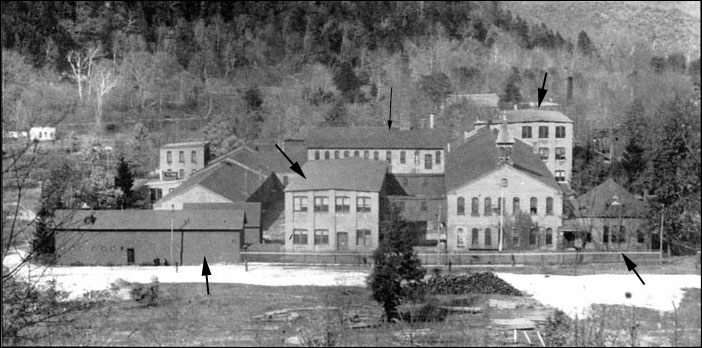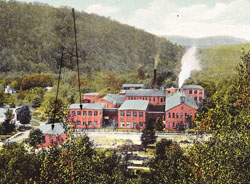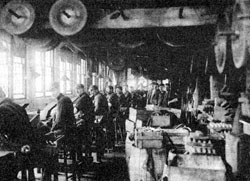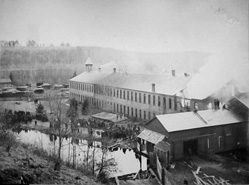Millers Falls Company: 1900-1910

Taken from an undated postal card put out by the E. M. Partridge Publishing Co., the illustration above shows the Millers Falls plant as it appeared about 1905. The image is relatively easy to date since the reverse side is the undivided type conforming to postal regulations in existence between 1901 and 1907. An examination of the photograph shows a good deal of construction had taken place in the previous fifteen years. The black arrows added to the photo indicate structures not present in the 1891 illustration that appeared in Wade, Warner and Company’s Picturesque Franklin County. The smaller arrow in the center part of the image identifies a second-story addition that was added to the boiler building, one of the site’s earliest structures. The small one-story addition, seen at the far right, was built for office space. It housed the general manager and adjoined the office of the plant superintendent. The plant’s main building, the older structure which sports a cupola on its roof, shows no evidence of the disastrous fire which had heavily damaged the back third of the building in about 1900.
Henry L. Pratt, longtime company president and the driving force behind the manufacturer’s success, died of heart failure in December 1900. While Edward Payson Stoughton, the firm’s New York sales representative, is sometimes considered to have followed him in an unbroken company presidency that lasted to 1918. The transition was not so simple, for although Stoughton’s obituary in the October 4, 1936, New York Times has him ascending to the position two years before Pratt’s death and serving as president for twenty years, it overlooks the years in the first decade of the twentieth century when Levi J. Gunn was company president and Stoughton was vice-president. Gunn’s presidency began in 1901 and ended in 1910 when he retired at the age of eighty years. While it is entirely possible that Stoughton viewed Gunn’s presidency as honorific and considered he ran the company from the vice-president’s office in New York, Gunn’s leadership within the firm cannot be ignored.
Levi Gunn assumed the presidency of the company during a period that could be considered the operation's best years. Fifteen percent stockholder dividends had become so common that a report of the annual shareholders' meeting in Greenfield's Gazette and Courier casually noted, "Usual 15 per cent dividend declared."(1) Business was booming, and in 1901, the operation constructed on a new building measuring forty by 220 feet. The first seventy-two feet of the structure were one-story and designed to house the drop forge and blacksmithing units; the second 148 feet were two-stories high and contained the packing and shipping departments. A year later, construction began on yet another building—this one two stories tall and measuring forty by 100 feet. Sales were so good the company added the facilities in the expectation that burgeoning demand would require a twenty-five percent increase in production. The operation was dependent on water power, and with the addition of the new facilities, the increased demand for energy put a strain on its thirty-year-old supply system. In 1903, the business widened and deepened its canal, installed new head gates, and sank its main wheel pit—changes it expected would increase available power by fifty percent.(2)
The Millers Falls Company's founders had been careful to secure rights to a substantial section of the Millers River, the source of the water that fed its canal. Hesitant to do anything which might compromise its power supply, the business guarded the resource carefully. Though it had allowed construction of a small dam upstream of its plant to power the local electric trolley, the company steadfastly refused to sell any part of its water privilege to a larger concern. The situation changed in 1902 when a group of investors from Holyoke wanted to locate a paper company upstream of the trolley dam. It dawned on Millers Falls executives that the sale of a water privilege would not only be profitable but that another upstream dam might alleviate chronic problems caused by the annual icing of the river. The new concern, organized as the Millers Falls Paper Company, built a thirty-foot-tall dam across the Millers River, creating a reservoir some three-quarters of a mile long. The new dam provided the papermaking operation with 1,200 horsepower of energy, an amount exceeding the capability of the Millers Falls Company's dam by some 300 percent. The paper plant was a large employer, and the tiny community of Millers Falls soon found itself in the midst of a housing shortage when building projects for the Millers Falls Company and the paper company created a shortage of carpenters. Nonetheless, eighteen new houses were started in the village in 1903. Eight of them were built by the Millers Falls Company for its employees.(3)
Due to its reliance on waterpower, the company emerged unscathed from the Anthracite Coal Strike that nearly paralyzed the country during the winter of 1902 and 1903. The miners' strike began in Pennsylvania during the summer of 1902 and lasted over 160 days. As winter approached, panic set in, and the price of coal skyrocketed. As a result, those seeking an affordable source of energy turned to firewood, a move that, in turn, drove prices for the substitute fuel to seven or eight dollars per cord. Though it is hard for a twenty-first century woodworker to imagine, prices reached the point that the odds and ends of the cocobolo lumber stored on the Millers Falls Company's premises became more valuable for firewood than for hand tool components. The operation was paying thirty dollars per ton for its best cocobolo logs, valued its larger pieces of lumber at twenty dollars a ton and considered smaller pieces had little value. The company began selling cocobolo scrap at six dollars a ton, delivered. Soon the Franklin County Bank was burning cocobolo in the fireplace of its board room, and Millers Falls Company directors Levi Gunn and George E. Rogers burned cocobolo wood to heat their homes. The coal strike was settled by early winter, but fuel supplies remained tight throughout the season.(4)
The tinted reproduction of the plant shown below is taken from a divided-back postcard of the type approved for usage in the United States in 1907. Although published by the Springfield News Company of Springfield, Massachusetts, the card was printed in Germany, a leading postcard manufacturer due to early success in mass producing color lithographs. Representing the plant as it appeared sometime between ca. 1905 and 1910, it depicts two buildings not included in the illustration at the top of the page. Despite the new buildings and growth, conditions inside the plant remained crowded and dreary, as can be seen in the image taken from a 1943 employees' magazine and identified as the "polishing room one year after new building was constructed." Though not necessarily the most cheerful places to work, the new buildings were far less prone to the devastating fires that cursed the older structures. The image of a fire at the most iconic of the plant's early buildings is courtesy of the Museum of Our Industrial Heritage in Greenfield and was once reproduced in the December 1943 issue of the Millers Falls employees' magazine where it was identified as "the last fire at the Millers Falls plant, which was about 1900."
The Millers Falls Company gained complete control of the Langdon Mitre Box Company in 1906.(5) The involvement of the Rogers family in Langdon had been extensive. C. C. Rogers had served as company president; George E. Rogers, while secretary of Millers Falls, had served as treasurer; David Rogers had patented the firm’s miter planer. The transaction was likely a simple affair involving an exchange of shares between various members of the Rogers family and Millers Falls. Although Langdon relied on the Millers Falls Company for the bulk of its sales, it had been putting out a small price list under its own name for some time. The parent company continued the tradition for at least a year after the buyout. A 1907 price list touts the New Langdon Acme Miter Box, the deluxe model that would anchor the line for over a half-century. The list also included, on the other end of the spectrum, the company’s Star Miter Box, an economy model that could be used with either a panel or a back saw.
When Levi Gunn retired, the company that he led had enjoyed a string of earnings rivaling any in its history. The operation employed some 400 workers and had almost doubled its product line in the years since 1900. During his tenure, the business built four major structures (the most recent in the previous year), reconstructed its dam, and made substantial improvements to its canal and mill race. It had just laid the foundation for a new sixty by 100 foot building, and plans were in the works for improving the water power available to the Lower Shop, an area that included structures built in the early 1870s by Charles H. Amidon and his brother Solomon after Charles had resigned as superintendent of the Millers Falls Company. The plans for the Lower Shop called for the installation of four water wheels to replace the existing single wheel, a move expected to would increase the energy available to that facility to 225 horsepower. On his retirement, Gunn sold his interest in the company to George E. Rogers, the secretary of the Millers Falls board. While Edward P. Stoughton was responsible for the success of the sales operation during the first decade of the twentieth century, Levi Gunn and his colleagues in Greenfield were responsible for the growth and efficiency of the manufacturing side of the business. Viewed in this light, Stoughton's claim to have been company president during Gunn's tenure was not only untrue and self-aggrandizing but indicative of a failure to recognize the importance of the manufacturing side of the operation.(6)
Illustration credits
- Postcard images are credited in text.
- Polishing room: Dyno-mite, December 1943.
- Fire: Museum of Our Industrial Heritage, Greenfield, Massachusetts. This photo of a photograph is copyright of the author.
References
- "Usual 15 Per Cent Dividend Declared." Gazette and Courier (Greenfield, Mass.) January 31, 1903, p. 1.
- "To Make Big Addition." Gazette and Courier (Greenfield, Mass.) May 25, 1901, p. 1; "A Boom in Millers Falls." Gazette and Courier (Greenfield, Mass.) November 23, 1901, p. 2; "Millers Falls Company Enlarges Again." Gazette and Courier (Greenfield, Mass.) November 22, 1902, p. 6; "To Improve Their Power." Gazette and Courier (Greenfield, Mass.) October 17, 1903, p. 6.
- "Franklin County." Boston Sunday Globe (Boston, Mass.) June 1, 1902, p. 2; "The Millers Falls Paper Company." Gazette and Courier (Greenfield, Mass.) December 6, 1902. p. 1: "Millers Falls Builds 18 New Houses." Gazette and Courier (Greenfield, Mass.) November 21, 1903, p. 2.
- "Franklin County: Local Stories of Wood and Coal." Boston Courier (Boston, Mass.) October 5, 1902, p. 2; "Total Coal Receipts Little More Than a Week's Supply." Gazette and Courier (Greenfield, Mass.) January 3, 1903, p. 6.
- “The Millers Falls Co.” Hardware Dealers Magazine, v. 43, no. 253, January 1915, p. 111.
- "The Millers Falls Company Changes its Officers." Gazette and Courier (Greenfield, Mass.) January 29, 1910. p. 2.


